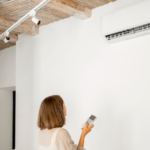Barcol-Air was founded in 1979 with a straight mission: to create individual solutions for optimal comfort for interiors. This climate-controlled ceiling system of a Swiss supplier company works through their subsidiaries in Germany, France and Italy, selling goods overseas.
Their product controls the temperature of the interior of a space with a fake ceiling thanks to the temperature transmission between the copper pipeline wielded to aluminum which is where water runs through. This process acclimatizes the living room. For example, if the running water is 16°C it can easily reach a 26°C inside the room and you can get a lower windchill index than the natural.

This system has several benefits: avoids draughts, annoying sounds, it provides a windchill comfort that is very different from conventional air-conditioners, it doesn’t require maintenance and allows energy savings, due to the water circuit that always keeps the same amount.
From Arce Clima, we have wide experience with this system’s assembly, like radiant ceilings for example, and we are currently working on projects in which we will install this aforementioned system. For further details, we interviewed Javier Gerpes, sales manager of Barcol-Air, that explains firsthand all the secrets of this efficient system when it comes to energy savings and ecological lifestyle.
One of the main products of Barcol-Air is the radiant ceilings. How does this acclimatization system work?
On the principle of ceiling refrigeration, water runs through the attached radiant panels and because of the high temperature, people and objects release heat to the cooling ceiling through radiation. At the same time, the room’s warm air goes up and gives its heat to the ceiling. The cold air goes inside the room again and it creates a pleasant room climate. This system is also known as climate ceiling.
The functioning of the ceiling’s heating and refrigeration system is based on cooling and warming a place’s surface with water. If water is hotter than the room is then it gets warm and if the water’s temperature is lower than the one inside the room, then it gets cold.
The acclimatization with radiant ceiling is a system for spaces and buildings and it also allows to save energy.

What is the installation process?
In the first place, we have to attach an activation circuit on the plate. It’s a hydraulic circuit made of copper coil tube of 12×1 mm combined with thermal conduction rails of aluminum.
With the insertion of the activation circuit, we have to make sure there is a good contact with the materials.
The assembling of refrigeration ceilings is simple and can be done by companies that are experts in the field of construction’s technical equipment.
The connection on the waterside is done in a standard way on the end of the pipeline with flexible pieces available on the market.

What are the main benefits of other systems?
- Ideal room temperature
- High efficiency
- Energy saving
- Low maintenance
- Silent system, no annoying noises.
- No draughts that can make dust flow.
- Compatibility with usual installations on ceilings (light, cameras, speakers, air diffuser…)
Is it good for all types of buildings and spaces?
We have done projects in offices, hospitals, auditoriums, banks, restaurants, theatres, libraries, particular houses, etc. So yes, we could say that climate ceilings are recommended in every facility that has people inside and would like to have an optimal interior temperature.

What are the areas and different kinds of spaces that require this system the most?
It’s clear that the higher claim is inside places where people work, such as offices, which is where we do most of our projects.
It’s scientifically proven that an optimal room temperature increases workers’ efficiency.
Talking about energy savings. What are the advantages of radiant ceilings in comparison to other climate systems?
The energy efficiency of climate ceilings is important in front of other climate systems.
Radiant ceilings allow us to reduce up to the minimum the need for air ventilation in a room, based on the group of people expected and the use of the space. The high thermal capacity of water in comparison to air is way more efficient because of the transportation of the same amount of heat in a climate ceiling than an air system, thus, the energy savings you get are great, avoiding expenses related to power that would be consumed by fans.
The initial investment is higher than conventional climate systems, however, it barely requires maintenance. In the long run, is it cheaper?
The initial costs are a little higher than other climate systems. Thanks to the almost inexistent maintenance expenses and power savings, the climate ceilings are a cheaper solution to get an optimal room temperature in the long run.

Even though there are countries in which this system is not extended, this is a popular method in a great part of central Europe. In what countries is traditional to install this model?
Switzerland, also Germany and a great part of France and Italy have a large number of offices in construction and these have climate ceilings.
At the same time, this system has become popular in other countries like Holand, Austria, Denmark and Sweden. We have also done projects in the United States and Poland.
Thanks to the efficiency of the system and the growing awareness of the population concerning energy saving and the ecological lifestyle, new countries are requesting our services.
What is the difference between Barcol-Air and the other climate ceiling providers? What are the advantages in relation to other competitors?
We invest a lot of time and money in progress and development. In our climate laboratory, which is located at the headquarter of the company in Switzerland, we develop, create and test our systems.
We develop new systems as an answer to the market’s demand, most competitors tend to just react.
Our vast knowledge of making, on an international level, allows us to do projects worldwide.













